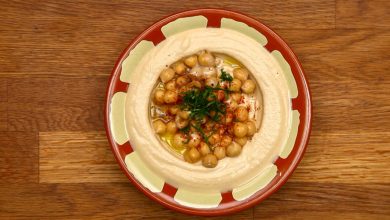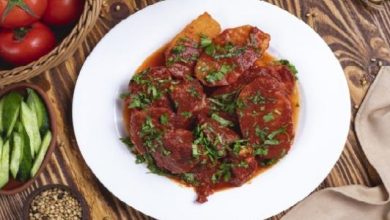Za’atar Manakish Recipe
Experience the authentic flavors of the Middle East with this traditional Za’atar Manakish recipe. These delicious flatbreads topped with a savory za’atar blend make for a perfect snack, appetizer, or accompaniment to any meal.
 Ingredients
Ingredients
For the Dough:
| Ingredient | Quantity | Notes |
|---|---|---|
| All-purpose flour | 4 cups | Plus extra for dusting |
| Warm water | 1 ½ cups | Around 110°F (43°C) |
| Active dry yeast | 2 teaspoons | Or instant yeast |
| Sugar | 1 tablespoon | Helps activate the yeast |
| Salt | 1 ½ teaspoons | Adjust to taste |
| Olive oil | 3 tablespoons | Extra virgin for best flavor |
For the Za’atar Topping:
| Ingredient | Quantity | Notes |
|---|---|---|
| Za’atar spice blend | ¾ cup | Store-bought or homemade |
| Olive oil | ½ cup | Extra virgin for best flavor |
| Sesame seeds (optional) | 2 tablespoons | For extra crunch and flavor |
Optional Garnishes:
| Ingredient | Quantity | Notes |
|---|---|---|
| Fresh mint leaves | As needed | For serving |
| Tomato slices | As needed | For serving |
| Cucumber slices | As needed | For serving |
| Labneh or yogurt | As needed | For dipping |
Instructions
1. Activate the Yeast
| Step | Action | Visual Cue |
|---|---|---|
| 1 | In a small bowl, combine warm water, sugar, and active dry yeast. | The mixture should be cloudy. |
| 2 | Stir gently until the yeast and sugar are dissolved. | |
| 3 | Let the mixture sit for about 5-10 minutes in a warm place. | The mixture should become frothy or bubbly on the surface. |
This step ensures that the yeast is active and ready to help the dough rise.
2. Prepare the Dough
| Step | Action | Visual Cue |
|---|---|---|
| 1 | In a large mixing bowl, combine all-purpose flour and salt. | The dry ingredients are well mixed. |
| 2 | Make a well in the center of the flour mixture. | A hollow space in the middle. |
| 3 | Pour the activated yeast mixture and 3 tablespoons of olive oil into the well. | Liquids are in the center. |
| 4 | Using a wooden spoon or your hands, gradually incorporate the flour into the liquids, mixing until a shaggy dough forms. | The dough starts to come together. |
| 5 | If the dough is too sticky, add a little more flour; if it’s too dry, add a bit more warm water, one tablespoon at a time. | The dough is manageable and soft. |
The goal is to achieve a soft, slightly sticky dough that is easy to knead.
3. Knead the Dough
| Step | Action | Visual Cue |
|---|---|---|
| 1 | Transfer the dough onto a lightly floured surface. | The dough is on the countertop or board. |
| 2 | Knead the dough by pushing it away with the heel of your hand, folding it over, and repeating this motion. | The dough becomes smoother. |
| 3 | Continue kneading for about 8-10 minutes until the dough is smooth, elastic, and springs back when poked. | The dough is elastic and less sticky. |
| 4 | Form the dough into a ball. | A smooth, round dough ball. |
Kneading develops the gluten in the flour, which gives the bread its structure and chewiness.
4. First Rise (Proofing)
| Step | Action | Visual Cue |
|---|---|---|
| 1 | Lightly oil a large bowl with a bit of olive oil. | Bowl has a thin oil coating. |
| 2 | Place the dough ball into the bowl, turning it to coat all sides with oil. | Dough is coated with oil. |
| 3 | Cover the bowl with plastic wrap or a damp kitchen towel. | Bowl is covered. |
| 4 | Place the bowl in a warm, draft-free area to rise for about 1 to 1.5 hours, or until the dough has doubled in size. | Dough has risen noticeably. |
Rising allows the yeast to ferment the sugars in the dough, producing gas that makes the dough expand.
5. Prepare the Za’atar Topping
| Step | Action | Visual Cue |
|---|---|---|
| 1 | In a medium bowl, combine the za’atar spice blend and olive oil. | A thick, spreadable paste forms. |
| 2 | Mix well until the mixture has a consistency similar to pesto; adjust with more oil or za’atar as needed. | Consistency is neither too thick nor runny. |
| 3 | If using sesame seeds, stir them into the mixture. | Seeds are evenly distributed. |
The topping should be easy to spread but not so thin that it runs off the dough.
6. Shape the Dough
| Step | Action | Visual Cue |
|---|---|---|
| 1 | Punch down the risen dough to release excess air. | Dough deflates. |
| 2 | Transfer the dough to a lightly floured surface. | Ready for shaping. |
| 3 | Divide the dough into 8-12 equal pieces, depending on desired size. | Dough pieces are roughly equal. |
| 4 | Shape each piece into a ball by pulling the edges underneath to form a smooth top surface. | Smooth, round dough balls. |
| 5 | Cover the dough balls with a kitchen towel and let them rest for 15 minutes to relax the gluten. | Dough is resting. |
Resting the dough makes it easier to roll out without shrinking back.
7. Preheat the Oven
| Step | Action | Visual Cue |
|---|---|---|
| 1 | Preheat your oven to 450°F (230°C). | Oven is heating. |
| 2 | Place a baking stone or an upside-down baking sheet in the oven to heat. | Surface is heating. |
A hot baking surface ensures a crispy crust.
8. Roll Out the Dough
| Step | Action | Visual Cue |
|---|---|---|
| 1 | On a lightly floured surface, roll out each dough ball into a circle about ¼ inch (0.6 cm) thick and 6-8 inches (15-20 cm) in diameter. | Thin, even circles of dough. |
| 2 | Transfer the rolled-out dough onto pieces of parchment paper for easy handling. | Dough is on parchment paper. |
Rolling the dough evenly ensures uniform cooking.
9. Apply the Za’atar Topping
| Step | Action | Visual Cue |
|---|---|---|
| 1 | Spoon a generous amount of the za’atar mixture onto each dough circle. | Topping is on the dough. |
| 2 | Using the back of the spoon, spread the mixture evenly, leaving a small border around the edges (about ½ inch or 1.25 cm). | Even layer of topping with a border. |
| 3 | Ensure that the topping is not too thick to prevent sogginess. | Topping is spread thinly but covers the dough. |
Leaving a border allows the edges to puff up and become crispy.
10. Bake the Manakish
| Step | Action | Visual Cue |
|---|---|---|
| 1 | Carefully slide the parchment paper with the prepared manakish onto the hot baking stone or baking sheet in the oven. | Manakish is in the oven. |
| 2 | Bake for 8-12 minutes, or until the edges are golden brown and the bottom is crisp. | Edges are golden; bottom is firm. |
| 3 | If necessary, rotate the manakish halfway through baking for even browning. | Manakish is evenly cooked. |
Baking time may vary depending on your oven; keep an eye on the first batch to adjust timing.
11. Cool and Serve
| Step | Action | Visual Cue |
|---|---|---|
| 1 | Remove the baked manakish from the oven and place them on a wire rack to cool slightly. | Manakish is cooling. |
| 2 | Repeat the baking process with the remaining prepared dough circles. | All manakish are baked. |
| 3 | Serve warm or at room temperature, garnished with fresh mint leaves, tomato slices, cucumber slices, or alongside labneh or yogurt if desired. | Ready to eat with optional garnishes. |
Za’atar manakish are best enjoyed fresh but can be reheated in the oven or toaster oven.
Nutritional Information (Per Serving)
Assuming 12 servings.
| Nutrient | Amount per Serving | % Daily Value |
|---|---|---|
| Calories | 280 kcal | 14% |
| Total Fat | 12 g | 18% |
| Saturated Fat | 1.8 g | 9% |
| Trans Fat | 0 g | — |
| Cholesterol | 0 mg | 0% |
| Sodium | 350 mg | 15% |
| Total Carbohydrates | 36 g | 12% |
| Dietary Fiber | 2 g | 8% |
| Sugars | 1 g | — |
| Protein | 6 g | 12% |
| Vitamin D | 0 µg | 0% |
| Calcium | 40 mg | 4% |
| Iron | 3 mg | 15% |
| Potassium | 90 mg | 2% |
Note: Percent Daily Values are based on a 2,000 calorie diet. Nutritional values are approximate and may vary depending on the exact ingredients used.
Tips and Variations
- Cheese Manakish: Add a layer of shredded Akkawi cheese, feta, or mozzarella on top of the za’atar before baking.
- Meat Topping: Substitute the za’atar with a spiced ground meat mixture for a different flavor.
- Whole Wheat Dough: Replace half of the all-purpose flour with whole wheat flour for a healthier version.
- Storage: Store leftover manakish in an airtight container at room temperature for up to two days or freeze for up to one month.
Homemade Za’atar Spice Blend (Optional)
If you prefer to make your own za’atar spice blend, here’s a simple recipe:
Ingredients:
| Ingredient | Quantity |
|---|---|
| Dried thyme | 2 tablespoons |
| Ground sumac | 2 tablespoons |
| Sesame seeds | 2 tablespoons |
| Dried oregano | 1 tablespoon |
| Salt | 1 teaspoon |
Instructions:
- Toast Sesame Seeds
- In a dry skillet over medium heat, toast the sesame seeds until golden brown, stirring frequently.
- Allow them to cool.
- Mix Spices
- In a bowl, combine the toasted sesame seeds with dried thyme, ground sumac, dried oregano, and salt.
- Mix well.
- Store
- Transfer the za’atar spice blend to an airtight container.
- Store in a cool, dry place for up to six months.
Cultural Significance
Za’atar manakish is a staple in Middle Eastern cuisine, often enjoyed for breakfast or as a street food snack. It’s especially popular in countries like Lebanon, Syria, Jordan, and Palestine. The combination of aromatic herbs and spices in za’atar is not only delicious but also believed to have health benefits, including boosting the immune system and improving mental clarity.
Serving Suggestions
- Breakfast: Serve with olives, fresh vegetables, and a cup of mint tea.
- Appetizer: Cut into wedges and serve on a platter at gatherings.
- Accompaniment: Pair with soups or salads for a complete meal.
- Sandwich Wrap: Roll up with sliced vegetables and cheese for a quick lunch.
Enjoy your homemade Za’atar Manakish!













